Elena Lupescu's Natural Pearl and Diamond Drop Earrings
Open FREE Unlimited Store Join Our Newsletter
Lareef A. Samad B.Sc (Hons)
Origin of Name
The pair of natural pearl and diamond drop earrings designed in the early 20th-century are believed to have been purchased by King Carol II of Romania, Queen Victoria's great-grandson, who presented it as a gift to his mistress since 1925, Elena Lupescu, who subsequently became his wife after his abdication in 1940 during World War II. They lived in exile first in Mexico and later in Portugal. When Elena died in 1977, she left some of her jewelry to a British friend she knew in Portugal, which included the pair of natural pearl drop earrings. The unnamed British woman brought the jewelry to Wiltshire when she returned to Britain. She never wore the pair of natural pearl and diamond drop earrings as such drop earrings had already gone out of fashion. Hence, she consigned them to a drawer, where it remained forgotten for the next 35 years. When the Wiltshire woman died, the pair of natural pearl and diamond drop earrings were inherited by her nephew, who happened to show the earrings casually to Jonathan Edwards, head of the jewelry department of Woolley & Wallis, when he and his wife visited the auction house to sell some other jewelry items, probably from the same collection. The couple had no idea of the value of the pair of pearl and diamond drop earrings, and according to Edwards were just blown away when he identified the natural pearls and told them their actual estimated value.
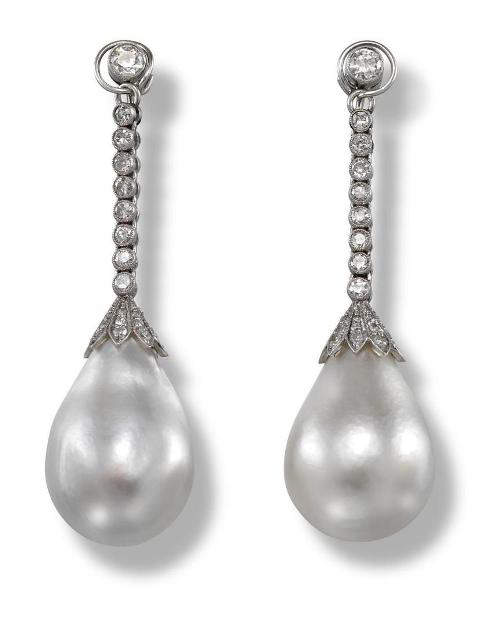
Pair of natural pearl and diamond drop earrings once owned by Elena Lupescu
Characteristics of the natural pearl and diamond drop earrings
Design features of the natural pearl and diamond drop earrings
The design features of the natural pearl and diamond ear-pendants show features characteristic of such ear-pendants from the Belle Époque period (1895-1914). Belle Époque meaning "Beautiful Times" in English is equivalent to the Edwardian Period in the United Kingdom.
The use of white on white color scheme on pieces of jewelry, incorporating white pearls and diamonds on platinum, was very popular during this period. The natural pearl and diamond ear-pendants conform to this white on white color scheme, being set on a white metal which is most probably platinum. Platinum is a malleable yet strong metal, ideal for crafting exquisite pieces of jewelry, first introduced during the Belle Époque period.
As all other ear-pendants, the pair of natural pearl and diamond ear-pendants are designed in two parts, a fixed upper part and a movable pendant lower part. The fixed upper part, right at the top of the pendant is mounted with a large Old-European circular-cut diamond. The movable pendant lower part is made up of the drop-shaped pearl, suspended by a bell-cap arrangement and a long line of 8 collet-set (bezel-set) Old-European circular-cut diamonds. The bell-cap made of seven segments is also pave-set with Old-European circular-cut diamonds.
Belle Époque features in the natural pearl and diamond drop ear-pendants
Hence, prominent Belle Époque features in the natural pearl and diamond earrings/ear-pendants can be listed as follows :-
1) The use of diamonds and pearls in the setting, the most predominant gemstones used during this period.
2) The use of white on white color scheme on the setting, white diamonds and pearls on platinum metal.
3) The use of Old-European circular-cut diamonds on the setting, the common cut of diamonds used in jewelry settings of the period.
4) The design features of the pendant such as the use of bell-cap and long collet lines to suspend the drop-shaped pearls.
Features of the two drop-shaped pearls in the pendants
The shape, color, overtone, luster, orient and surface quality of the pearls
The two drop-shaped pearls in the pendants are almost identical in shape, with an almost perfect drop-shape, but slightly different in size. The dimensions of the pearl, the longest length and width of the pearl are not given.
According to the Swiss Gemological Institute (SSEF), which examined the drop-shaped pearls, they are natural saltwater pearls with white body color and blue and rose overtones.
The luster and orient of the pearls caused by reflection and refraction respectively, are in keeping with the saltwater origin of the pearls, superior to the luster and orient of freshwater pearls.
The surface quality of the pearls are also excellent and appear to be blemish-free.
The size and weight of the pearls. Elena Lupescu's pearls are among the largest symmetrical drop-shaped pearls in the world
The SSEF report does not give the dimensions of the pearls, but the weights of the two pearls are given. While one pearl weighs 34.508 carats (138.032 grains) the other pearl weighs 33.235 carats (132.94 grains)
In the table of famous nacreous single pearls arranged in descending order of weights, the Elena Lupescu's Drop-shaped pearls occupy the 21st position. These pearls are also among the largest symmetrical drop-shaped pearls in the world, according to the table.
Table of famous nacreous single pearls arranged in descending order of weights
| S/N | Name of Pearl | Weight in Carats and Grains | Shape of Pearl |
Type of Pearl | Color of Pearl |
| 1 | Danat Sheikha Fathima bint Mubarak Pearl | 856.58 carats, 3426.32 grains | Baroque | Saltwater, nacreous pearl | Convex front-Purplish brownish gray. Concave back- dark gray to black |
| 2 | Pearl of Asia | 600 carats, 2,400 grains | Baroque, garden-egg shaped | Saltwater, nacreous pearl | White |
| 3 | Arco-Valley Pearl | 575 carats, 2300 grains | Baroque | Saltwater, nacreous pearl | White |
| 4 | Big Pink Pearl | 470 carats, 1,880 grains | Baroque | Saltwater, nacreous abalone pearl | Pink |
| 5 | Hope Pearl | 450 carats, 1,800 grains | Baroque drop-shaped | Saltwater, nacreous pearl | White |
| 6 | Christopher Walling Abalone Pearl | 187.5 carats, 750 grains | Horn shaped | Saltwater , nacreous pearl | Multi-colored |
| 7 | Imperial Hong Kong Pearl | 127.5 carats, 510 grains | Irregular drop | Saltwater, nacreous pearl | White |
| 8 | Gogibus Pearl | 126 carats, 504 grains | Pear-shaped drop | Saltwater, nacreous pearl | White |
| 9 | Shah Sofi Pearl | 125 carats. 500 grains | Pear-shaped drop | Saltwater, nacreous perl | White |
| 10 | Survival Pearl | 90.35 carats, 361.40 grains | Baroque | Freshwater, nacreous pearl | White |
| 11 | La Regente | 75.67 carats, 302.68 grains | Pear-shaped drop | Saltwater, nacreous pearl | White |
| 12 | Pearl of Kuwait | 64.35 carats, 257.40 grains | Asymmetrical drop-shape | Saltwater, nacreous pearl | White |
| 13 | Paspaley Pearl | 60.94 carats, 243.76 grains | Perfectly spherical | Saltwater, nacreous, cultured pearl | White |
| 14 | Largest natural freshwater nacreous pearl in the world, that appeared at Christie's sale 7664 at Dubai | 60.36 carats, 241.44 grains | Near-Spherical | Freshwater nacreous pearl | Yellowish- orange to pinkish-orange |
| 15 | Natural Grey/Brown Pearl | 56.81 carats, 227.24 grains | Symmetrical drop-shape | Saltwater, nacreous pearl | Grey/Brown |
| La Peregrina (Original weight) | 55.95 carats, 223.8 grains | Pear-shaped drop | Saltwater, nacreous pearl | White | |
| 16 | Sara/Tavernier/Shaista Khan Pearl | 55.0 carats, 220 grains | Drop-shaped | Saltwater, nacreous pearl | Gray |
| 17 | La Peregrina after drilling and polishing in 1913 | 50.96 carats, 203.84 grains | Pear-shaped drop | Saltwater, nacreous pearl |
White |
| 18 | Peacock Throne Pearl | 50 carats, 200 grains | Pear-shaped drop | Saltwater nacreous pearl | Yellow |
| 19 | Mancini Pearls | 50 carats, 200 grains. 50 carats, 200 grains | Drop-shaped pearls | Saltwater nacreous | White |
20 |
Moghul Pearls | 45.5 carats, 182 grains. 45.5 carats, 182 grains | Pear-shaped drop | Saltwater nacreous pearls | White |
21 |
Elena Lupescu's Natural Pearl and Diamond Drop Earrings | 34.508 carats (138.03 grains); 33.235 carats (132.94 grains) | Symmetrical drop-shape | Saltwater nacreous pearl | White |
| 22 | Drexel Pearl | 33.80 carats, 135.2 grains | Symmetrical drop-shape | Saltwater nacreous pearl | Black Tahitian |
| 23 | La Pelegrina one | 33.29 carats, 133.16 grains | Pear-shaped drop | Saltwater, nacreous pearl | White |
| 24 | Largest natural near-spherical saltwater nacreous pearl in the world that appeared at Wooley & Wallis auction in London WW | 33.147 carats, 132.59 grains | Near-spherical | Saltwater, nacreous pearl | White |
| 25 | Charles II Pearl | 32.5 carats, 130 grains | Pear-shaped drop | Saltwater, nacreous pearl | White |
| 26 | Tararequi Pearls | 31 carats, 124 grains | Pear-shaped drop | Saltwater, nacreous | White |
| 27 | Bapst Pearls | 113.75 grains, 113.25 grains | Perfectly spherical pearls | Saltwater nacreous pearls | White |
| 28 | La Pelegrina two | 27.88 carats, 111.5 grains | Perfectly spherical pearl | Saltwater nacreous pearl | White |
| 29 | La Reine De Pearls | 27.5 carats, 110 grains | Perfectly spherical pearl | Saltwater, nacreous pearl | White |
| 30 | Oviedo Pearl | 26 carats, 104 grains | Perfectly spherical pearl | Saltwater, nacreous | White |
| 31 | Queen/Patterson Pearl | 23.25 carats, 93 grains | Baroque | Freshwater, nacreous pearl | White |
| 32 | Paspaley Drop-shaped Pearls | 18.75 carats, 75 grains. 18.75 carats, 75 grains | Drop-shaped pearls | Saltwater, nacreous pearl | White |
| 33 | Finest black pearl in Europe in 1900 | 12.25 carats, 49 grains | Pear-shaped drop pearl | Saltwater, nacreous pearl | Black pearl with green overtone |
© internetstones.com
History of the Elena Lupescu's Natural Pearl and Diamond Drop Earpendants
The source of the white saltwater drop-shaped nacreous pearls
The possible oyster species in which the drop-shaped pearls originated
Given the enormous size of the drop-shaped pearls, and the period in which the ear-pendants were designed - the Belle Époque period (1895-1914) - the most probable oyster species in which drop-shaped pearls originated, is Pinctada maxima (silver-lipped pearl oyster), whose natural home is the South Sea, the sea between the southern coast of China and the northern coast of Australia, that connects the Indian Ocean to the Pacific Ocean. This was the period during which a shell-button and natural pearl industry based on the oyster species Pinctada maxima existed in Broome, northwestern Australia.
Pinctada maxima, the largest naturally occurring pearl oyster in the world, can grow to a maximum diameter of 30 cm (12 inches). Hence, the enormous drop-shaped pearls can easily grow inside such an equally enormous oyster. Pinctada maxima also known as the South Sea Pearl Oyster produces pearls with a range in size from 9 mm to 20 mm. The silvery-white color of the drop-shaped pearls with blue and pink overtones is characteristic of pearls produced by the silver-lipped pearl oyster.
The possible country where the drop-shaped pearls originated ?
Given the fact that the pearl drop ear-pendants were designed during the Belle Époque period (1895-1914), the most probable country where the drop-shaped pearls originated is Australia. This was the period when Broome in northwestern Australia was the center of the international mother-of-pearl industry, the raw material for the shell-button industry. The mother-of-pearl industry was based on the oyster species Pinctada maxima, which was harvested in the wild, from the South Sea off the coast of Broome. The peak period of Broome's mother-of-pearl industry was around 1925 when 400 pearling luggers were engaged in the industry, producing almost 80% of the world's requirement of mother-of pearls.
Hundreds of thousands of South Sea pearl oysters were shucked in the mother-of-pearl industry to separate the mother-of-pearl from the contents of the oyster. The occasional South Sea pearls found inside the oysters was a by-product of the industry. Given the fact that millions of oysters were shucked in this industry several thousand South Sea pearls were produced annually as a by-product of this industry. The matching pair of drop-shaped pearls in ear-pendants were probably part of this annual harvest.
When did Carol II gift the Natural Pearl and Diamond Drop Ear-pendants to his mistress Elena Lupescu ?
The Natural Pearl and Diamond Drop Ear-pendants was designed during the Belle Époque period between 1895 and 1914
Elena Lupescu's Natural Pearl and Diamond Ear-pendants are believed to be a gift by King Carol II of Romania to his mistress Elena Lupescu. The next logical question that arises from this is, when did Carol II gift the Natural Pearl and Diamond Ear-pendants to his mistress Elena Lupescu ? An indication to a possible answer to this question is already provided by the design features of the drop ear-pendants which are distinctly Belle Époque, a jewelry period that extended from 1895 to 1914 or 1920 if at all there was any jewelry manufacturing during World War I. Thus, the natural pearl and diamond ear-pendants was no doubt produced during the Belle Époque period, but may or may not have been purchased during this period. A definite answer to this question lies in the study of the biographies of both Carol II and Elena Lupescu, with a view of finding out when actually did their extra-marital relationship begin.
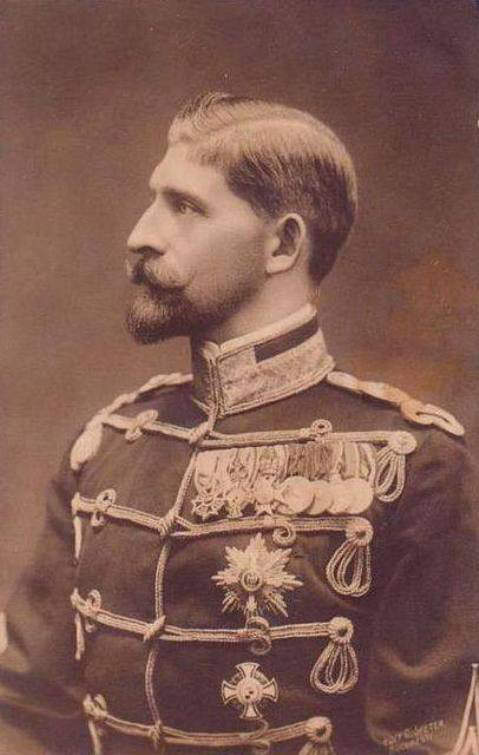
Ferdinand I - King of Romania and Father of Carol
Carol IIs first marriage in 1918 which was annuled in 1919
Carol II, who was the eldest son of King Ferdinand I of Romania and his spouse Marie of Edinburgh, was born on October 15, 1893, at Sinaia, Romania. As Crown Prince, Carol sat in the Romanian Senate from November 1914 at the age of 21 years.In 1918, at the age of 25, he married Joanna Marie Valentina Lambrino, the daughter of a Romanian general, at the Cathedral Church of Odessa, Ukraine. The marriage did not last long as it did not receive the approval of the King and parliament, since the Romanian constitution forbade the Crown Prince from marrying a commoner and was annuled by the Supreme Court on March 29, 1919. However, the couple lived together for sometime even after the annulment, and their only child, Carol Lambrino was born on January 8, 1920.

Crown Prince Carol with his first wife Marie Valentina Lambrino
Carol IIs second marriage to Princess Helen of Greece which ran into trouble with the entry of Elena Lupescu into Carol's life
Carol's next marriage was to his second cousin Princess Helen of Greece and Denmark, whom he married in Athens, Greece, on March 10, 1921. This marriage too, soon ran into trouble as a third woman entered Carol's life, Elena Lupescu, once married and divorced to an Officer of the Romanian Royal Army, whom he first encountered in March 1923. Elena Lupescu was the daughter of a Jewish pharmacist Nicolae Lupescu, who adopted Orthodox Christianity, the Official religion in Romania and his wife Eliza, also a Jewish convert to Roman Catholicism. Elena was raised from birth as a Catholic and was educated in a Roman Catholic boarding school, run by Bavarain nuns, one of the best girls' school in the country.
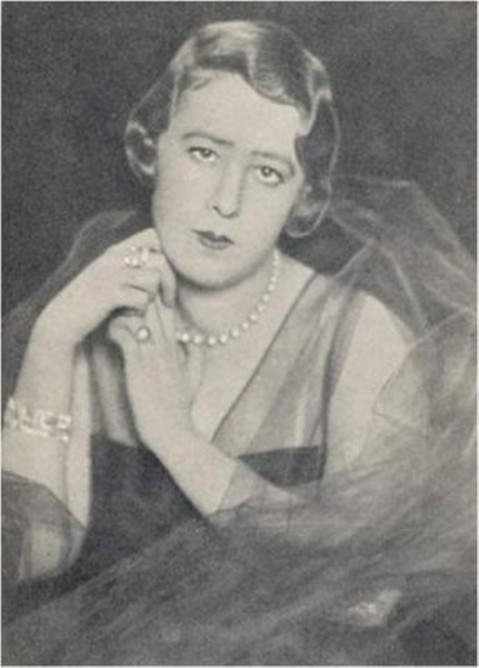
An early image of Elena Lupescu

Elena Lupescu and Carol II
Elena first met Carol in March 1923 but serious relationship between them started in 1925
Elena first met Carol in March 1923, when she was still married to the Army Officer Ion Tampeanu. After several subsequent encounters Carol and Elena began a serious relationship in February 1925, which lasted until Carol's death in 1953. Elena Lupescu became Carol's mistress in 1925, after Carol and Elena ended up in Milan, Italy, after Carol visited England to represent the Rumanian royal family at the funeral of Queen Alexandra, causing a scandal that led Crown Prince Carol to renounce his right to the throne on December 28, 1925, in favour of his son by Crown Princess Helen of Greece, Michael I, who succeeded to the Romanian throne in July 1927, after the death of King Ferdinand I. The renunciation was ratified by Parliament on January 4, 1926, which also banned Carol and Elena from returning to Romania. Crown Princess Helen divorced Carol in 1928.

Princess Helen of Greece with her son Crown Prince Michael
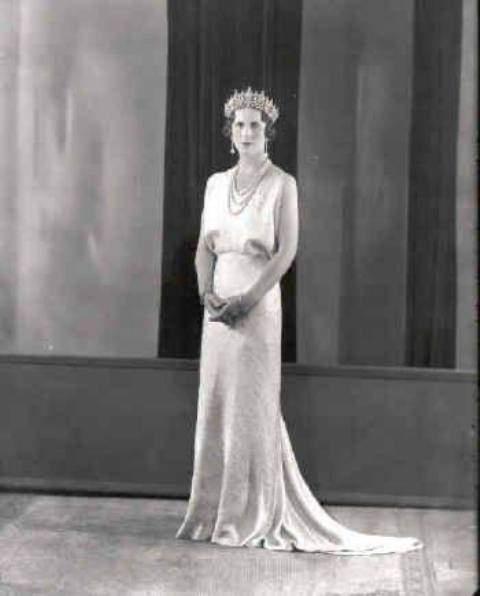
Another image of Princess Helen of Greece and Denmark, second wife Carol II
Carol and Elena return to Romania in 1930 after exile in Europe from 1925 to 1930
Carol and Elena's exile in Europe was short lived, as the regency created to look after young Michael I's throne headed by Carol's younger brother Prince Nicolae became weak and unstable, and Carol was invited back to Romania to take charge of the throne and charter the destinies of the country. Carol returned to Romania on June 6, 1930, and soon after that Parliament declared his renunciation invalid and proclaimed him King of Romania. Elena Lupescu returned to Romania in October 1930, and joined King Carol II playing the role of his wife and partner in the difficult task of ruling the nation.
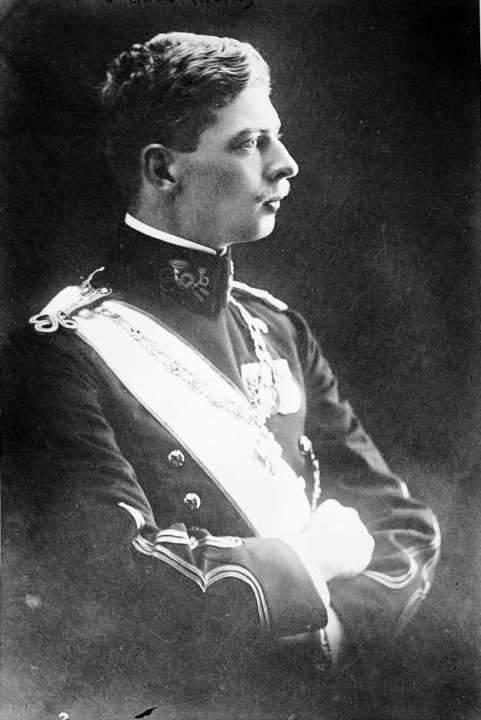
King Carol II of Romania - King of Romania 1930-1940
The Natural Pearl and Diamond Drop Ear-pendants was most probably purchased by Carol II during his exile in Europe between 1925 and 1930
Hence, in all probability the natural pearl and diamond drop ear-pendants was purchased by Carol II during Carol and Elena's exile in Europe between 1925 and 1930. The jewelry piece designed during the Belle Époque period was probably lying on the shelf of a jewelry store, in one of the capital cities of Europe like Paris, where it was purchased by Carol and presented to his sweetheart Elena Lupescu. Paris was one of the capital cities in Europe where exquisite pieces of jewelry were turned out during the Belle Époque period and Cartier was in forefront of the jewelry manufacturing industry during this period. One of the Belle Époque pieces of jewelry created by Cartier incorporating natural pearls and diamonds, that appeared at a Christie's Geneva Sale on May 12, 2010, is given below.
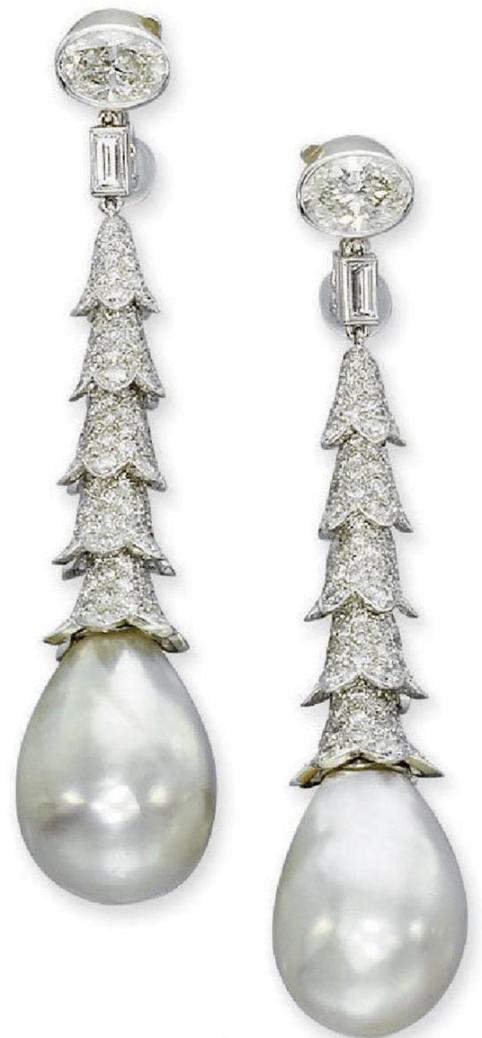
Belle Époque Pair of Natural Pearl and Diamond Ear Pendants by Cartier
Another Belle Époque piece created by unknown jewelry designers from Paris, that appeared at the same Christie's Geneva Sale in May 2010 is given below. Please note the diamond set bell-cap and collet line on the two side pendants, similar to the bell-cap and collet line on the Elena Lupescu's Natural Pearl and Diamond Ear-pendants.
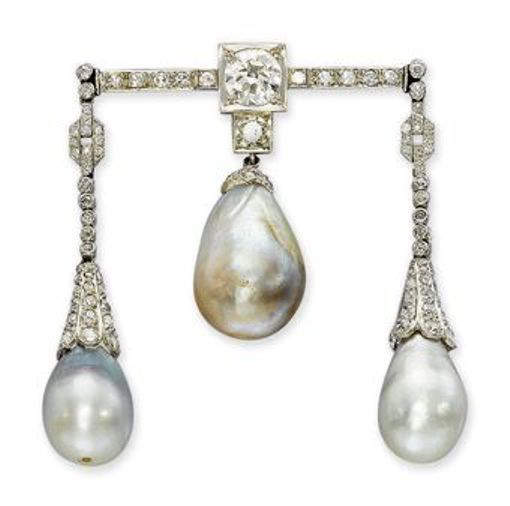
Belle Époque Natural Pearl and Diamond Triple Pendant Brooch
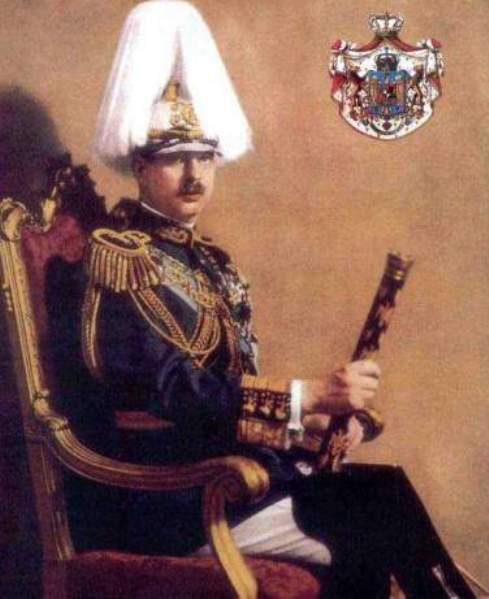
King Carol II of Romania
King Carol IIs iron-fisted rule from 1930-1940 that transformed him from a constitutional monarch to an absolute monarch
From 1930 to 1940, King Carol II of Romania, with a strength of character and political acumen not possessed by his younger brothers, influenced the course of Romanian political life by clever manipulation of rival factions and political parties, safeguarding and enhancing his position as the King of Romania, eventually abolishing parliamentary democracy and proclaiming himself as dictator on February 10, 1938. The abolition of the multi-party democratic system was legalized by the introduction of a Corporatist Constitution that enshrined the principle of the King's supremacy, abolishing the principle of seperation of powers and restricting a series of civic rights and freedoms. The new constitution was approved by a plebiscite and the country's one and only legal party, the National Renaissance Front was formed in December 1938. However, King Carol IIs dictatorial rule lasted only two years until 1940.
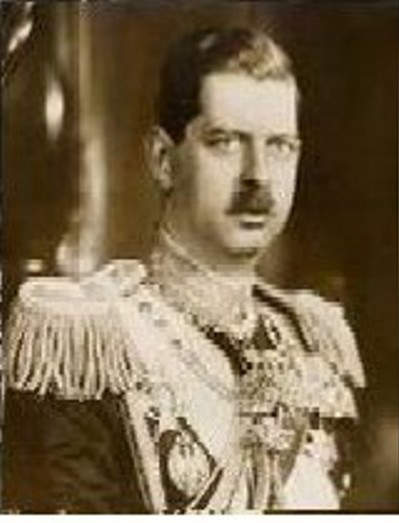
Another Image of Carol II - King of Romania
The explosive international situation of World War II that led to the loss of Romania's territorial integrity and the ousting of King Carol II by a military coup
Romania had no escape from the emerging explosive international situation centered in the heart of the European continent, dictated by the fascist regime in Nazi Germany, even though King Carol II adopted a position of neutrality when war broke out in September 1939. The rapidly changing situation in Europe in 1940 and domestic political upheaval caused by internal fascist forces urging an alliance with Nazi Germany undermined Romania's neutral stand. Romania's guarantors of territorial integrity, France and Britain, were no longer able to fulfill their assurances, with the fall of France in May 1940. Romania then turned to Germany with the hope of obtaining similar guarantees, unaware of the fact that Germany had already secretly granted its consent to Soviet territorial claims on its territory by a secret pact signed in 1939.
As a result of this a series of territorial disputes with Romania's neighbours were resolved unfavorably to Romania in the summer of 1940, resulting in the loss of territory to the Soviet Union, Hungary and Bulgaria. This resulted in the plumetting of the popularity of King Carol IIs government and the stregthening of the fascist and military factions, who staged a coup, forcing King Carol II to abdicate in favour of his son Michael on September 5, 1940. General Ion Antonescu assumed dictatorial powers with the support of the army and most political parties.
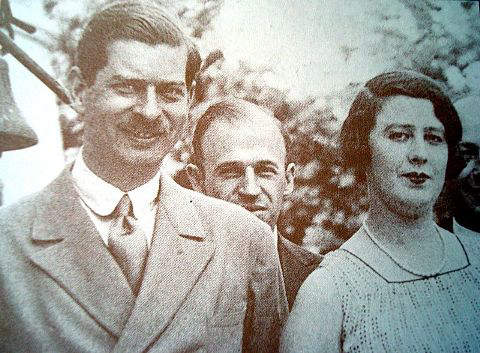
Carol II and Elena Lupescu
Ex-King Carol II and his mistress Elena Lupescu go into exile in Mexico after his abdication
A few days after his abdication, ex-king Carol, his beloved mistress Elena Lupescu and their faithful aide left Bucharest, Romania by Special Train, carrying most of their personal belongings. They crossed the border in a hail of bullets, and first travelled to Spain and later Portugal, and crossing the Atlantic by ship they eventually settled in Mexico City. Elena Lupescu fell sick while living in Mexico City, initially believed to be her inability to tolerate the City's high altitude.
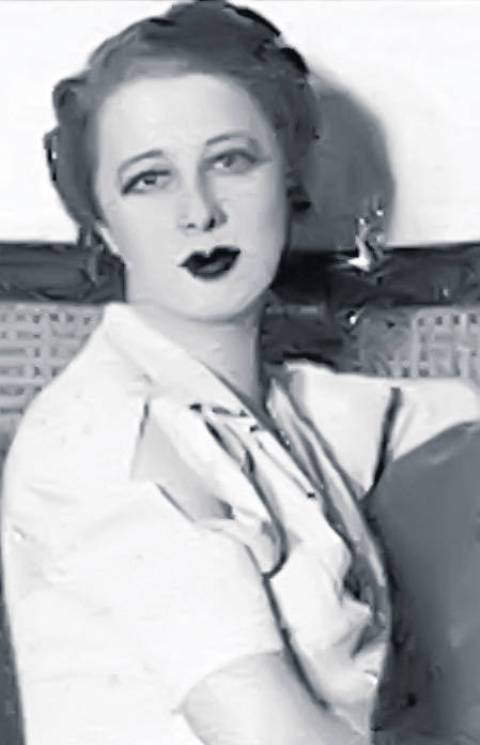
Another image of Elena Lupescu
Carol and Elena move to Rio in Brazil, where they get formally married in 1947
So, they moved to Rio de Janeiro, Brazil, in 1944, but her health condition did not improve. By early 1947 her condition was diagnosed as pernicious anaemia.
After 22 years of life together as husband and wife, Carol and Elena formally married in June/July 1947 in a hotel room in Rio de Janeiro. It was Carol's third marriage and Elena's second. After the marriage Elena Lupescu was referred to as Princess Elena of Romania.

Carol II and Elena Lupescu at their wedding in Rio in 1947
Carol and Elena move to Portugal on doctor's advice, where Ex-King Carol died of a heart attack in 1953.
Elena Lupescu's health improved while living in Rio de Janeiro, but she was advised by doctors to move to a more temperate climate. Accordingly Carol and Elena finally settled in Estoril, Portugal, where Carol died suddenly of a heart attack in 1953. Ex-King Carol II of Romania was buried in the Royal Pantheon of the Monastery of Sao Vicente de Fora in Lisbon. Elena Lupescu is famously reported to have said at the funeral of her beloved husband, "Adieu, Amour de ma Vie" - Bye, Love of my Life.
Images of Elena Lupescu wearing a pair of pearl drop earrings. Is it possible that the pearl drop earrings she is wearing are the same pearl drop earrings which are the subject of this webpage ?
Following are some of the images of Elena Lupescu wearing a pair of pearl drop earrings, which has a striking resemblance to the pearl drop earrings that is the subject of this webpage.
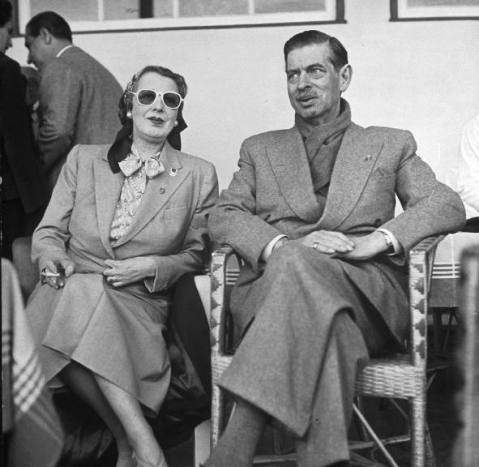
Carol II and Elena Lupescu in 1950 - Elena is wearing a pair of pearl drop earrings.

The pearl drop earrings Elena Lupescu is wearing in this phtograph bears a striking resemblance to the pearl drop earrings considered in this webpage

Elena Lupescu in Bermuda in 1941 wearing the same pair of pearl drop earrings
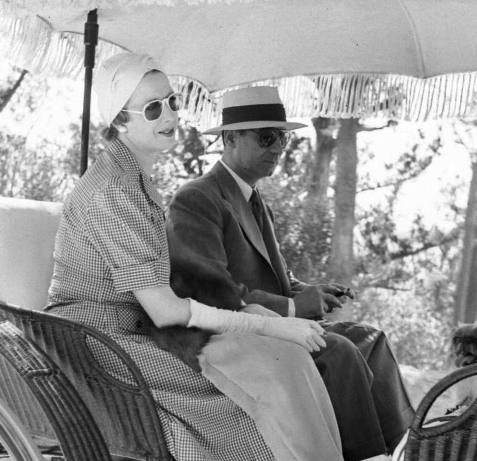
Elena Lupescu riding a carriage with Carol in Bermuda in 1941. Here too she appears to be wearing the same pair of pearl drop earrings
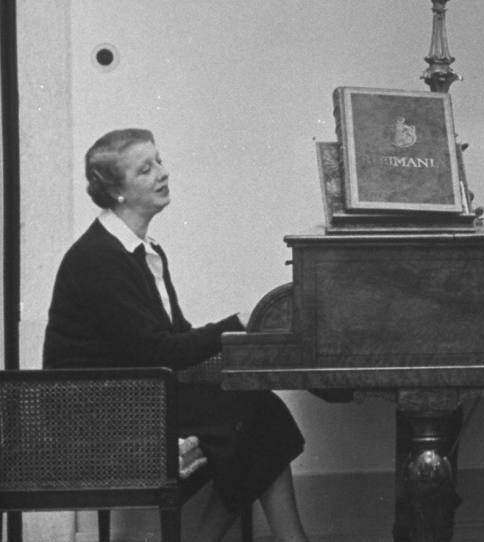
Elena Lupescu playing the piano in 1950. She seems to be wearing the same pair of pearl drop earrings
Death of Elena Lupescu in 1977. Elena bequeaths some of her jewelry to a British Lady from Wiltshire that included the pair of natural pearl and diamond drop earrings
After her beloved husband's death Elena Lupescu continued to live in Portugal. During this period she made the acquaintance of a British lady from Wiltshire. Elena Lupescu outlived her husband by 24 years. When Elena died in 1977, she left some of her jewelry to her British friend, which included the pair of natural pearl and diamond drop earrings.
Elena Lupescu died on June 29, 1977 aged 81 years. She was buried next to her beloved husband in the same Monastery in Lisbon where Carol II was buried.
Re-Discovery of Elena Lupescu's Natural Pearl and Diamond Drop Earrings in the year 2012
When the British Lady from Wiltshire returned to Britain from Portugal, she carried with her the jewelry given by her friend Elena Lupescu. The jewelry included the Natural Pearl and Diamond Drop Earrings, which she never wore as wearing such enormous drop earrings had long gone out of fashion. She consigned the drop earrings to a drawer where it remained forgotten for the next 35 years, until year 2012. When the Lady from Wiltshire died the jewelry and drop earrings were inherited by her nephew, who happened to show the earrings casually to Jonathan Edwards, head of the jewelry department of Woolley & Wallis, when he and his wife visited the auction house to sell some other jewelry items, probably from the same collection. The couple had no idea of the value of the pair of pearl and diamond drop earrings, and according to Edwards were just blown away when he identified the natural pearls and told them their estimated value.
The Natural Pearl and Diamond Drop Earrings set a world record for such a piece of Jewelry at a Woolley & Wallis auction held on April 26, 2012, by selling for £1,618,000 equivalent to US$ 2,780,000
The Elena Lupescu's Natural Pearl and Diamond Drop Earrings were entrusted to Woolley & Wallis auction house for sale by its owners, the nephew of the Wiltshire Lady to whom the drop earrings were bequeathed by her friend Elena Lupescu. The auction house advertised the sale of the historic pair of natural pearl and diamond drop earrings, at its Salisbury Saleroom auction due to come up on April 26, 2012. A pre-sale estimate of £80,000-£120,000, equivalent to US$140,000 - US$ 206,000 was placed on the lot.
The lot was accompanied by two lab reports. One report by the Swiss Gemological Institute (SSEF) bearing No.62440 and dated March 1st, 2012, stated that both pearls are natural saltwater and weigh 34.508cts (138.03 grains) and 33.235cts (132.94 grains).
The second report by the Gem and Pearl Laboratory of London (GPL), bearing No. 5262 and dated 21st February 2012, stated that both pearls are natural saltwater.
The pair of natural pearl drop earrings generated huge interest from collectors around the world. The auction took place on Thursday, April 26, 2012 and as anticipated generated a frenetic round of bidding in which both live participants and phone bidders took part. Soon the sale value hit the £1million mark and after this according to Jonathan Edwards the bidding just went bersek. The anonymous bidder on the telephone who eventually purchased the drop earrings, just would not stop. He would'nt give up and was very determined to get the pearls at whatever cost. The fierce bidding generated gasps of astonishment in the auction room, which ended in a round of applause when the hammer was brought down finally at £1,400,000. The actual price after addition of buyer's premium worked out to £1,618,000 equivalent to US$ 2,780,000 the highest price ever paid for a pair of natural pearl and diamond ear-pendants. See table below.
The previous record for a pair of natural pearl and diamond ear-pendants was held by Cartier's Natural Pearl and Diamond Ear Pendants that sold for US$ 419,710 at Christies Geneva Magnificent Jewels Sale held on May 12, 2010.
Some of the natural pearl and diamond ear pendants sold at public auctions and the prices realized
| S/N | Name of Pearl and Diamond Ear Pendants | Weight of the Pearls | Dimensions | Auction House and Year of Salle | Price Realized at the Auction |
| 1 | Marie Mancini pearl and diamond ear pendants | Each pearl weighing approx. 200 grains | not known | Christie's, New York, October 1979 | US$ 253,000 |
| 2 | Pair of Antique Natural Pearl and Diamond Ear Pendants | 107.44 grains
91.28 grains |
21.1 mm x 14.3 mm
21.18 mm x 13.45 mm |
Christie's, Dubai, April 29, 2008 | Presale estimate US$ 180,000-250,000.
Price realized US$217,000 |
| 3 | Fine Pair of Natural Pearl and Diamond Ear Pendants | not known | 15 mm x 9.38 mm
14 mm x 9.23 mm |
Christie's Dubai, April 29, 2008 | Presale estimate US$ 60,000-80,000
Price realized US$ 157,000 |
| 4 | Pair of Diamond and Pearl Pendants | Each pearl weighing approx. 120 grains | not known | Sotheby's Geneva, May 11, 2010 | Presale estimate US$ 17,300-26,000
Price realized US$ 168,500 |
| 5 | Pair of Art Deco Natural Pearl and Diamond Pendant Earrings | not known, but approx. 70 grains from the conversion table for spherical pearls | 13.45-13.50 mm x 11.50 mm
13.25-13.30 mm x 10.90 mm |
Christie's, Geneva, May 12, 2010. | Presale estimate US$ 99,268-144,390
Price realized US$ 165,176 |
| 6 | Cartier's Natural Pearl and Diamond Ear Pendants | 101.2 grains
94.0 grains |
not known | Christie's, Geneva, May 12, 2010 | Presale estimate US$ 76,707-112,805
Price realized US$ 419,710 |
| 7 | Elena Lupescu's Natural Pearl and Diamond Ear Pendants | 138.03 grains
132.94 grains |
not known | Woolley & Wallis, Salisbury , April 26, 2012 | Presale estimate £80,000-£120,000. (US$140,000 - US$ 206,000 Price realized £1,618,000 (US$ 2,780,000) |
© internetstones.com
You are welcome to discuss this post/related topics with Dr Shihaan and other experts from around the world in our FORUMS (forums.internetstones.com)
Back to Famous Diamonds,Gemstones and Pearls
Related : -
2)Pair of Antique Natural Pearl and Diamond Ear Pendants
3)Pair of Fine Natural Pearl and Diamond Ear Pendants
4)Pair of Natural Pearl & Diamond Ear Pendants
5)Pair of Art Deco Natural Pearl & Diamond Pendant Earrings
6)Cartier's Natural Pearl and Diamond Ear Pendants
7)Belle Époque Pearl & Diamond Triple Pendant Brooch
External Links :-
Wooley & Wallis Salisbury Salerooms - 26 April 2012 Jewelry Auctions - Lot 1844
References :-
1) Woolley & Wallis, Salisbury Salerooms - April 26, 2012, Jewellery Auction - www.woolleyandwallis.co.uk
2) Pearl earrings left in drawer since 1970s fetch £1.6m at auction - Steven Morris - theguardian.com. Thursday 26 April 2012.
3) Earrings found in drawer in Wiltshire sell for £1.6m - BBC News Wiltshire, 26 April 2012 - www.bbc.co.uk
4) Carol II of Romania - From Wikipedia, the free encyclopedia
5) Magda Lupescu - From Wikipedia, the free encyclopedia.
6) Romania in World War II - From Wikipedia, the free encyclopedia.
Powered by Ultra Secure
Amazon (USA) Cloud Network

Founder Internet Stones.COM
Register in our Forums
| Featured In
|
|
|
|
|
|
|
|


















